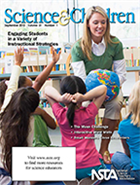Engaging students in a variety of instructional strategies
By Mary Bigelow
Posted on 2013-09-05
 What would implementing the NGSS “look like” in a classroom? Each of the featured articles in this issue highlights several classroom strategies that you can use to start making connections to the disciplinary core ideas, practices, and crosscutting concepts of the NGSS.
What would implementing the NGSS “look like” in a classroom? Each of the featured articles in this issue highlights several classroom strategies that you can use to start making connections to the disciplinary core ideas, practices, and crosscutting concepts of the NGSS.
If you teach K-5, be sure to read this month’s guest editorial The Next Generation Science Standards and the Common Core State Standards: Proposing a Happy Marriage. The author suggests ways in which these two documents complement each other and the provides several examples of the connections between science and literacy.
The moon is certainly the source of much folklore, legends…and misconceptions. The Moon Challenge* shows how the authors challenged misconceptions with patterns (moon phases), a research project, and trade books. When is the Next Full Moon? (Formative Assessment Probes)* uses the idea of a “concept cartoon” to probe student’s understanding. [SciLinks: Moon Phases]
Small Wonders-Close Encounters* shows strategies to introduce students to the world of digital microscopy. The authors share what to look for in a digital microscope and offer suggestions for differentiating the lesson for younger students, English language learners, and special education students. [See how to use a tablet as a digital microscope] The Science 101 column asks (and answers) How Does an Electron Microscope Work?* [SciLinks: Microscopes, Electron Microscope]
I heard a teacher lament that with the new standards, all of the fun activities will have to go. I hope she reads Desert Survivors* in which a puppet play based on the “Survivor” TV program teaches students about argumentation and desert habitats. Students had to research the desert environment to equip their contestants. [SciLinks: Desert] Young students are interested in animals and their homes. Habitable Homes (Teaching Through Trade Books)* has two 5e lesson plans (K-2 and 3-5) on habitats and biomes. [SciLinks: What is a Habitat? Adaptations of Animals, Habitats, Biomes, Habitats and Niches]
I was never very good at teacher-created bulletin boards. But word walls were different! Interactive Word Walls shows how to kick up the traditional word wall a few notches (in five steps) to make it truly a student project. The examples are wonderful! This might be more of a challenge for middle or high school levels, where the teacher meets 5-6 classes each day, but I’d be interested in how this could be implemented in these upper grades. Science vocabulary is also the theme of Science as a Second Language. The authors share several strategies for helping English language learners with science vocabulary, including foldables, DOTS charts, and U-C-ME graphic organizers, examples of which can be found in this issues Connections*.
The authors of What Does Culture Have to Do With Teaching Science?* share strategies for capitalizing on the cultural backgrounds students bring to the classroom. Using Hindu beliefs as an example, they show how students can make connections between cultural beliefs and scientific concepts. [SciLinks: How Do Plants Grow?] Food for Thought (The Early Years)* has lesson ideas for helping our youngest scientists find evidence of how animals use plants for food and shelter. [SciLinks: How Do Animals Help Plants, Plants as Food, What Are the Parts of a Plant?]
* Many of these articles have extensive resources to share, so check out the Connections for this issue. Even if the article does not quite fit with your lesson agenda, there are ideas for handouts, background information sheets, data sheets, rubrics, and other resources.
Disclaimer: The views expressed in this blog post are those of the author(s) and do not necessarily reflect the official position of the National Science Teaching Association (NSTA).


